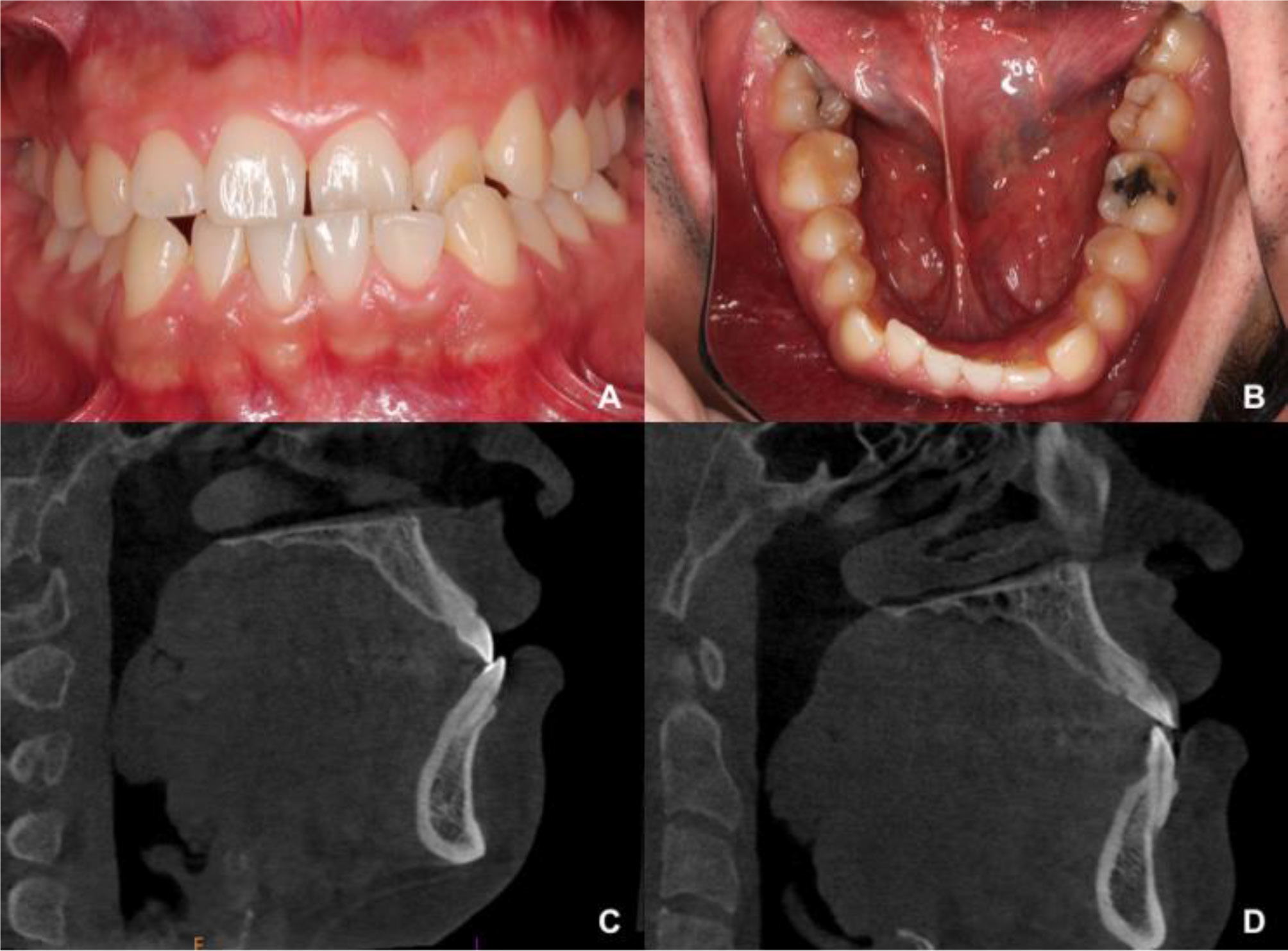Resumen
Las contenciones fijas en ortodoncia han demostrado tener excelentes resultados para la estabilidad y durabilidad del tratamiento. A pesar de esto, se ha observado que existen ciertos movimientos dentarios indeseados totalmente diferentes a una recidiva a su posición inicial previa al tratamiento de ortodoncia. El llamado “efecto giro” es uno de ellos, y se caracteriza por ser una inclinación en sentidos opuestos de los caninos contralaterales, en donde uno presenta una inclinación hacia vestibular y el otro hacia lingual o palatino. Se presenta principalmente en la mandíbula, a pesar de que la contención permanece perfectamente adherida a los dientes. El objetivo de esta revisión bibliográfica es evaluar los distintos factores reportados en la literatura que puedan estar relacionados con la aparición del “efecto giro” y qué tan relevantes pueden ser en su desarrollo. Como conclusión es importante considerar el carácter multifactorial de este tipo de complicaciones, en donde el tipo y calidad del alambre que se utilice para la contención, junto con las características periodontales del paciente demostraron tener cierta participación en la génesis de este, por lo tanto, resulta fundamental concientizar a los pacientes de la importancia de los controles ortodóncicos periódicos posteriores al retiro de los aparatos fijos para monitorear y controlar los resultados oclusales logrados y el estado de los dispositivos de contención instalados.
Referencias
Kučera J, Marek I. Unexpected complications associated with mandibular fixed retainers: A retrospective study. Am J Orthod Dentofacial Orthop. 2016;149(2):202–11.
Pancherz H, Bondemark L. The bite-type malocclusion classification – An extended Angle-method. Is the new classification reliable? APOS trends orthod . 2021;11(100):100–5.
Shaughnessy TG, Proffit WR, Samara SA. Inadvertent tooth movement with fixed lingual retainers. Am J Orthod Dentofacial Orthop. 2016;149(2):277–86.
Nanda RS, Nanda SK. Considerations of dentofacial growth in long-term retention and stability: is active retention needed? Am J Orthod Dentofacial Orthop . 1992;101(4):297–302.
Lai CS, Grossen JM, Renkema A-M, Bronkhorst E, Fudalej PS, Katsaros C. Orthodontic retention procedures in Switzerland. Swiss Dent J. 2014;124(6):655–61
Katsaros C, Livas C, Renkema A-M. Unexpected complications of bonded mandibular lingual retainers. Am J Orthod Dentofacial Orthop . 2007;132(6):838–41.
Renkema A-M, Renkema A, Bronkhorst E, Katsaros C. Long-term effectiveness of canine-to-canine bonded flexible spiral wire lingual retainers. Am J Orthod Dentofacial Orthop. 2011;139(5):614–21.
Roussarie F, Douady G. A side-effect of bonded retention wires: the “wire syndrome”: part 1. J dentofac anom orthod. 2016;19(1):106.
Pazera P, Fudalej P, Katsaros C. Complication sévère d’une contention collée linguale mandibulaire. Orthod Fr. 2014;85(2):217–22.
Kapila S, Sachdeva R. Mechanical properties and clinical applications of orthodontic wires. Am J Orthod Dentofacial Orthop. 1989;96(2):100–9.
Sifakakis I, Pandis N, Eliades T, Makou M, Katsaros C, Bourauel C. In-vitro assessment of the forces generated by lingual fixed retainers. Am J Orthod Dentofacial Orthop. 2011;139(1):44–8.
Horowitz SL, Hixon EH. Physiologic recovery following orthodontic treatment. Am J Orthod. 1969;55(1):1–4.
Johnston CD, Littlewood SJ. Retention in orthodontics. Br Dent J . 2015;218(3):119–22.
Little RM, Riedel RA, Artun J. An evaluation of changes in mandibular anterior alignment from 10 to 20 years postretention. Am J Orthod Dentofacial Orthop. 1988;93(5):423–8.
Little RM. Stability and relapse of dental arch alignment. Br J Orthod. 1990;17(3):235–41.
Richardson ME. Late lower arch crowding facial growth or forward drift? Eur J Orthod. 1979;1(4):219–25.
Sadowsky C, Schneider BJ, BeGole EA, Tahir E. Long-term stability after orthodontic treatment: nonextraction with prolonged retention. Am J Orthod Dentofacial Orthop. 1994;106(3):243–9.
Kocher KE, Gebistorf MC, Pandis N, Fudalej PS, Katsaros C. Survival of maxillary and mandibular bonded retainers 10 to 15 years after orthodontic treatment: a retrospective observational study. Prog Orthod. 2019;20(1):28.
Mills JR. The stability of the lower labial segment. A cephalometric survey. Dent Pract Dent Rec. 1968.
Pizarro K, Jones ML. Crown inclination relapse with multiflex retainers. J Clin Orthod. 1992
Sifakakis I, Eliades T, Bourauel C. Residual stress analysis of fixed retainer wires after in vitro loading: can mastication-induced stresses produce an unfavorable effect? Biomed Tech (Berl). 2015;60(6):617–22.
Dahl EH, Zachrisson BU. Long-term experience with direct-bonded lingual retainers. J Clin Orthod. 1991;25(10):619–30.
Arnold DT, Dalstra M, Verna C. Torque resistance of different stainless-steel wires commonly used for fixed retainers in orthodontics. J Orthod. 2016;43(2):121–9.
Pandis N, Vlahopoulos K, Madianos P, Eliades T. Long-term periodontal status of patients with mandibular lingual fixed retention. Eur J Orthod. 2007;29(5):471–6.
Levin L, Samorodnitzky-Naveh GR, Machtei EE. The association of orthodontic treatment and fixed retainers with gingival health. J Periodontol. 2008;79(11):2087–92.
Richardson ME, Gormley JS. Lower arch crowding in the third decade. Eur J Orthod. 1998;20(5):597–607.
Al-Moghrabi D, Pandis N, Fleming PS. The effects of fixed and removable orthodontic retainers: a systematic review. Prog Orthod 2016;17(1):24.


